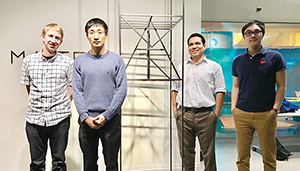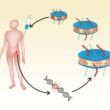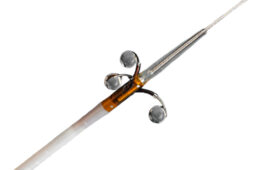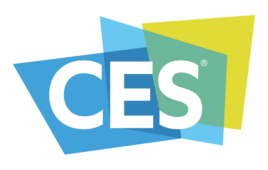
Latona Therapeutics team members Dylan Nichols, Meng-Yang Chen, Antonio Olivo and Jason He (from left to right). Not pictured are Aakanksha Rangnekar and Han Li. [Image courtesy of Latona Therapeutics]
It’s been more than 20 years since the FDA approved the first nanoparticle drug, Doxil. At the time, nanoparticles were heralded as a way to more efficiently deliver drugs that traditionally come with burdensome side effects, such as chemotherapy.
Since then, scientists have published an array of preclinical studies and academic papers evaluating various types of nanoparticles, including liposomes, antibodies and more. But some experts point out that in many instances, nanoparticle technology stalls before it can even get to the clinic.
“Well, they haven’t really lived up to their promise,” said Keith Horspool, VP of pharmaceutics at Boehringer Ingelheim.
Some industry players are moving away from nanoparticles: Cambridge, Mass.–based Dicerna Pharmaceuticals bailed on its lipid nanoparticle delivery program in September last year. Cerulean Pharma ditched its nanoparticle-drug conjugate technology and was bought by Daré Bioscience in March, with 11 of Cerulean’s 19 employees laid off in the process.
Still, scientists launching nanoparticle startups are optimistic that their preclinical research will lead to treatments that will better the lives of patients.
Latona Therapeutics is hoping it can tackle the historical hurdles and get its light-activated nanoparticle cancer therapy to market. The Chicago-based startup launched out of a competition hosted by the Center for Advancing Innovation and the National Institutes of Health’s National Cancer Institute.
The challenge tasked university researchers to commercialize an NIH invention, and the team from Latona Therapeutics chose a photodynamic nanoparticle, designed to target cancerous tumors.
Biomedical engineers embedded a light-activated molecule within a lipid bilayer and wrapped it around a chemotherapeutic. When the nanoparticle is exposed to infrared light, it releases the chemotherapy in a particular region to target cancer cells.
The 6-person company is still in its early stages of development. Right now, they are working on acquiring a license from the NIH and raising capital, according to Illinois Tech biomedical engineering PhD student Jason He. As the group begins its journey to the clinic, experts have some insights about the hurdles they might face.
Escaping the preclinical lurch
There are thousands of academic papers describing scientists’ preclinical evaluations of nanoparticle technology. This is a symptom of a common trend, especially at universities or institutions that receive government funding for their work, according to Horspool.
“These government institutions really reward people on the number of academic papers. It doesn’t incentivize the clinical testing necessarily. It incentivizes doing another bit of science which may not be driving these things forward,” Horspool said.
Latona Therapeutics and other young startups could run into another problem garnering funds: There are only a few approved nanoparticle drugs, and investors are wary. Startups need to prove that their nanoparticle-based solution is unique and necessary, noted Cornell Stamoran, Catalent Pharma Solutions’s VP of corporate development & strategy.
“What problem, what real market or formulation problem, does it actually solve that’s not solvable with something cheaper, off-patent and available already?” Stamoran asked.
Stamoran is careful to say that not all dose forms are interchangeable. At Catalent’s Applied Drug Delivery Institute, Stamoran said they’ve seen how impactful any choice about formulation and delivery can be for a patient.
“The research we’ve done shows that almost every design decision about a drug, whether it’s about the molecule, the formulation or the dose or the drug delivery device if you need one, as well as the package of course, can affect the patient outcome. If you do it wrong, especially, it’s higher odds of leading to discontinuation or other things. I’m not trying to suggest that all dose forms are interchangeable,” he said.
But investors and business partners are not likely to take on a lot of risks. So far, nanoparticles have not proven to be scalable, Stamoran said.
“What would entice a customer to be the first one in an unproven manufacturing process that hasn’t necessarily been scaled up properly to real commercial scale and would need to prove a complex release profile in unproven technology?” Stamoran said. “Why would they add a risk if they don’t need to?”
Solving a delivery problem
Used to deliver drug cargo to specific parts of the body, nanoparticles are thought to work largely because of their size. They can’t slip past cells in the blood vessels and escape to surrounding tissues. Instead, they linger around the bloodstream, which gives them the chance to get to a tumor.
Last year, Warren Chan at the University of Toronto published a review examining how effective nanoparticles are at reaching their target. Chan’s results were seemingly dismal: Across 117 studies from 2005 to 2015, the median efficiency was 0.7%. In other words, for every 1,000 nanoparticles, only 7 reached tumors in an animal model.
Experts in the field questioned the findings of Chan’s study, saying that the 0.7% number is out of context. Chan’s team did not compare delivery efficiencies with nanoparticle-free drugs. When other studies compare nanoparticles to free drugs, they have found that the free drugs accumulate with efficiencies that are a 10th or even a 100th of Chan’s 0.7% figure.
Chan responded to his critics saying that regardless, 0.7% is too low of a delivery efficiency, and it could prevent nano-drugs from moving from animal models to the clinic. The review’s authors showed that a dose of particles with a delivery efficiency of 1% would not be feasibly scalable.
Too soon to call it quits
Despite the challenges, there is still optimism and excitement in the industry. And there’s no shortage of problems to be solved, Stamoran said, noting that success is a matter of figuring out how nanoparticles can be most useful.
“There are some interesting injectable formulation technologies using nanoparticles in early stage development that seem to suggest there is some ability to achieve sustained release injectable applications,” he said. “Targeted, localized delivery of gene therapy, cell therapy, RNAi – all of those things are problems that are can be solved.”
To position themselves as innovators in the field of drug delivery, startups need to put the work in early, according to Horspool.
“[They need] a good business plan where you clearly have a good idea of what you’re trying to achieve,” he said. “You’ve got to have compelling data to convince anyone these days.”
He added that attracting help from a bigger company at an early stage can be a critical step in moving a technology along.
“What you really want is somebody to help you validate your system. You can do a lot on your own, but some other validation can be really quite effective,” he said.
To convince bigger companies to help them, startups need to thoroughly understand their technology and how it can differentiate itself from competitors, Stamoran said. He added that startups should do as much as they can to de-risk their technology, like consulting with people that are familiar with potential regulatory risks.
“If you get the model right, a platform technology business can be sustainable. But it’s difficult to do it solely on the back of early stage technology because there’s so much desire to be 2nd using the new technology platform and not the desire to be first.”
Latona Therapeutics is undeterred. The company is still in its infancy and has a long road ahead of them. “The way I see it, there are challenges, but there is also opportunity,” He said.
[Want to stay more on top of MDO content? Subscribe to our weekly e-newsletter.]







